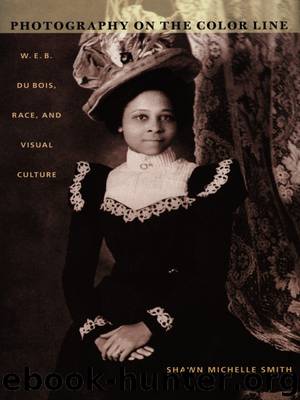Photography on the Color Line: W. E. B. Du Bois, Race, and Visual Culture by Shawn Michelle Smith

Author:Shawn Michelle Smith
Language: eng
Format: epub
Publisher: Duke University Press
Published: 2012-09-17T16:00:00+00:00
Missives of Love and Terror
In her recent study of “the black male body as spectacle,” Deborah McDowell has argued, “It is well known and widely conceded that black death has made good spectacle for [white] audiences who have relished it historically in every form from fatal floggings to public lynchings.”19 In turn-of-the-century photographs of lynchings, black death clearly functions as a spectacle for a white audience. But unlike the media images McDowell studies, the photographs of lynchings do not simply presume a later white audience—they actually represent one, for a portion of the white audience enthralled by the spectacle of black death it has created is represented within many of these photographic frames. In this chapter, I focus on the spectacle of this white audience, refusing to forget the black bodies at the center of these images, refusing to forget the murdered African American men and women, but also refusing to repeat and reinforce the spectacle of black death.20 For as Saidiya Hartman has argued concerning written texts, too often the reproduction of tales of black agony “immure us to pain by virtue of their familiarity” and work to “reinforce the spectacular character of black suffering.”21 Further, I would argue that Hartman’s concerns become magnified when one addresses visual texts, in which the representation and reproduction of the violated black body can function as a kind of fetish, obscuring from view the white torturers who also inhabit these images.
Lynching photographs present a spectacle of whiteness; they represent a gruesome ritual of white identification that many white scholars, like myself, would, perhaps, rather not see. But if, as Richard Dyer has argued, whiteness has historically secured its representational power through invisibility, by being that which is not seen,22 then looking at whiteness, making white bodies bear the burden of the gaze, can become an important critical task. This chapter examines the spectacle of whiteness posed in lynching photographs in order to see extreme machinations of white consolidation, in order to see some of the visual workings of whiteness.
In pursuing this analysis, I rely on the archive of lynching photographs and postcards that James Allen has collected and reproduced in Without Sanctuary: Lynching Photography in America, a book that corresponds to and complements an important and controversial exhibit of the same name. Without Sanctuary presents ninety-eight lynching photographs, many of them postcards, ranging in date from 1870 to 1960, depicting murdered men and women, white and black, in states across the country. The vast majority of the images, however, were made in the first decade of the twentieth century, in the South (many in Georgia), and they overwhelmingly depict murdered young black men. Allen has carefully compiled notes and historical information concerning the alleged events surrounding the lynchings, their aftermath, and the photographs that document them, identifying the murdered individuals, and the dates on and places at which the murders took place.23
Without Sanctuary provides an important and extensive record of lynching in the United States, but it is also a disturbing book,
Download
This site does not store any files on its server. We only index and link to content provided by other sites. Please contact the content providers to delete copyright contents if any and email us, we'll remove relevant links or contents immediately.
| Photo Essays | Photojournalism |
Shoot Sexy by Ryan Armbrust(17139)
Portrait Mastery in Black & White: Learn the Signature Style of a Legendary Photographer by Tim Kelly(16483)
Adobe Camera Raw For Digital Photographers Only by Rob Sheppard(16383)
Photographically Speaking: A Deeper Look at Creating Stronger Images (Eva Spring's Library) by David duChemin(16159)
Bombshells: Glamour Girls of a Lifetime by Sullivan Steve(13107)
Art Nude Photography Explained: How to Photograph and Understand Great Art Nude Images by Simon Walden(12346)
Perfect Rhythm by Jae(4621)
Pillow Thoughts by Courtney Peppernell(3394)
The Book of Joy by Dalai Lama(3217)
Good by S. Walden(2913)
The Pixar Touch by David A. Price(2739)
Fantastic Beasts: The Crimes of Grindelwald by J. K. Rowling(2543)
A Dictionary of Sociology by Unknown(2517)
Humans of New York by Brandon Stanton(2379)
Read This If You Want to Take Great Photographs by Carroll Henry(2303)
Stacked Decks by The Rotenberg Collection(2270)
On Photography by Susan Sontag(2129)
Photographic Guide to the Birds of Indonesia by Strange Morten;(2088)
Insomniac City by Bill Hayes(2083)
